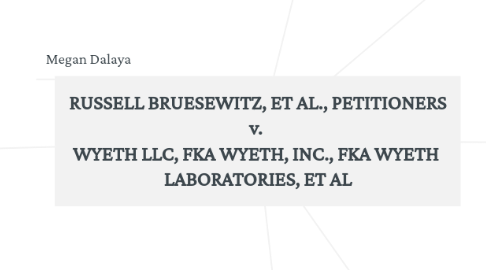
1. Three I's
1.1. Impact
1.1.1. Brady v. National Football League, 644 F.3d 661 (8th Cir. 2011)
1.1.1.1. CASE: NFL Players dissolved their union prior to the expiration of their CBA, in an effort to thwart the league's plans of implementing a legally acceptable lockout as a tactic to expedite reaching an agreement.
1.1.1.1.1. NFL continued with lockout, NFL players filed a claim as they said without the Union in place, the lockout is not an acceptable tactic for negotiation. Court placed an injunction on the lockout.
1.1.1.2. Used to set precedent on determining intent / interpretation of a term or concept. Should be based on whether there is a unified understanding of the rule across parties.
1.1.1.2.1. In Brady v. NFL - "labor dispute" In Bruesewitz v. Wyeth the understanding of Comment k.
1.1.2. American Home Products Corp. v. Ferrari, 710 S.E.2d 771 (Ga. 2011)
1.1.2.1. Used to set precedent of preemptive effect of the National Childhood Vaccine Injury Compensation Act of 1986
1.1.2.2. CASE: Similar to Bruesewitz v. Wyeth, except court ruled in favor of plaintiffs- child's parents. When appealed, court referenced supreme court holding that the act preempts design-defect claims in order to reverse and remand case with direction to consider Bruesweitz v. Wyeth.
1.2. Importance
1.2.1. This case takes a look at the ability of a federal statute to prevent claims deemed acceptable by state law.
1.2.1.1. What is interesting here is the actual analysis of whether the statute did preempt design defect claim and protect manufacturers despite that explicitly being its intent.
1.2.2. Cautionary tale to companies and consumers across industries about the legal language that exists to protect either party- in this case the manufacturer
1.3. Influence
1.3.1. As noted in the case, the law discussed has great influence on maintaining a pharmaceutical company's comfort level in providing vaccines.
1.3.1.1. Without the NCVIA and this ruling, vaccine manufacturers may refrain from production for fear of claims despite FDA adherence. In the past 50 years, Pharma has moved further away from the vaccine space.
1.3.1.1.1. Vaccines are not as profitable a space as other drugs, for a few main reasons: Most vaccines are administered once a year or one in a lifetime (rarely) Live vaccines are tricky to handle FDA regulations are even more stringent for QC This means that the benefit for companies to enter into the space is low if there is no protection against certain claims.
1.3.2. This decision fosters an environment where the FDA's approval process is left to manage all potential design defects for vaccines. This in turn creates a very strict pre-approval process and a lax post-approval environment for the product. This forces pharmaceutical companies to invest a significant amount of money to get their vaccines approved.
1.3.2.1. Highlights need for post-approval regulations to manage vaccines.
2. Megan Dalaya
3. Facts
3.1. Parties
3.1.1. Plaintiffs- Bruesewitz family (Hannah Bruesewitz's parents)
3.1.2. Defendants - Wyteth LLC (pharmaceutical company)
3.2. Case
3.2.1. Vaccine was administered to Hannah Bruesewitz in 1992 - dosage in accordance with CDC guidelines
3.2.1.1. DTP vaccine manufactured by Lederle Laboratories purchased by Wyeth in 1994. Wyeth stopped manufacturing vaccine in 1998.
3.2.1.2. Hannah had a reaction within 24 hours and over 100 seizures within the next month. She was diagnosed with developmental delays.
3.3. Procedural History
3.3.1. 1995- Hannah’s parents filed a vaccine injury petition in the US Court of Federal Claims which was denied.
3.3.1.1. 2005- The Bruesewitzes rejected the judgment and award, and filed a lawsuit in Pennsylvania state court.
3.3.1.1.1. Alleged that defective design caused Hannah’s disabilities making company subject to strict liability and liability for negligent design under PA common law
3.3.2. US District Court for the Eastern District of Pennsylvania granted Wyeth summary judgment on the strict-liability and negligence design-defect claims.
4. Issues before the court
4.1. Does the National Childhood Vaccine Injury Act of 1986 protect vaccine manufacturers from design-defect claims?
4.1.1. Specifically section 22(b)(1)
5. Rule of Law
5.1. Act- §300aa–22(b): “No vaccine manufacturer shall be liable in a civil action for damages arising from a vaccine-related injury or death associated with the administration of a vaccine after October 1, 1988, if the injury or death resulted from side effects that were unavoidable even though the vaccine was properly prepared and was accompanied by proper directions and warnings.” (BRUESEWITZ ET AL. v. WYETH LLC, FKA WYETH, INC., ET AL., 2011)
5.1.1. Effects of Design-defect torts
5.1.1.1. to prompt improved designs
5.1.1.2. to provide compensation for injuries
5.1.2. No previous interpretation of §300aa–22(b)(1) / structure of NCVIA
5.1.3. Requires relief to be sought through the compensation program before filing suit for more than $1,000
5.2. Products-liability law
5.2.1. What are grounds for liability?
5.2.1.1. Defective manufacture
5.2.1.2. Inadequate directions or warnings
5.2.1.3. Defective design
6. Conclusion
6.1. Judgement Affirmed.
6.1.1. National Childhood Vaccine Injury Act preempts design-defect claims against vaccine manufacturers
7. Application
7.1. Assessing the intention of the statute as it pertains to this case
7.1.1. Did the manufacturer take the proper steps for side effects to be considered "unavoidable"?
7.1.1.1. Were there proper warnings?
7.1.1.1.1. Yes.
7.1.1.2. Was manufacturing was completed according to spec and FDA regulations?
7.1.1.2.1. Yes.
7.1.2. Are design-defect liability considerations included in the statute?
7.1.2.1. Statute intentionally excludes design-defect, as it touches on points #1 and #2 of products-liability law, but fail to touch on point 3.
7.1.2.1.1. Dissenting opinion: Justice Sotomayor expressed concern that the decision puts more weight on the FDA's approval process than there should be. She argues that the statute does contemplate design-defect claims.
7.1.3. Is the questionable ability of the Act to spur innovation in the same manner as state-law tort systems relevant to the case?
7.1.3.1. No
7.2. Interpreting comment k- regarding ‘unavoidably unsafe’ products
7.2.1. Does comment k have a defined meaning that can be applied to this case?
7.2.1.1. Disagreement in lower courts as to definition of Comment k.
7.2.1.1.1. Court uses most plausible meaning using traditional statuatory interpretation

